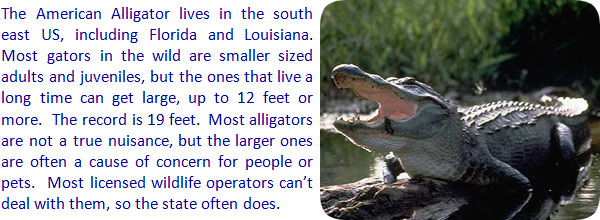- info@wildlifeanimalcontrol.com
Call us for help in your town
Wildlife Control Education
How to Trap Alligators in a Lake, Pond, Yard, or Canal

Need alligator removal in your hometown? We service over 500 USA locations! Click here to hire us in your town and check prices - updated for year 2020.
How To Trap An Alligator
Alligators are lizards that can range from only a few inches in length up to those that can be larger than the average human. The majority of species to be found in North America will be quite large, and can be found in the rivers and wetlands in many of the southern states of the United States including Florida and Louisiana. Alligators will very rarely attack humans, although they can be a threat to children and anyone that accidentally wanders into their nesting area. Alligators are also known to prey on domestic pets if they stray into urban or suburban areas.
Trapping Techniques To Catch An Alligator
It is worth pointing out that alligators are large and dangerous animals, and trying to trap them should only be carried out by someone that is trained and experienced in this kind of wildlife control.
The most common trapping technique for those catching alligators is to bait a large fishing hook and to hang it from a tree branch overhanging the water about two feet above the surface of the water. Once the alligator takes the scent and jumps out of the water to eat the bait, the hook will catch in its mouth and prevent it from escaping. This is not a particularly kind method, and the alligator may die from the hook, or will need to be euthanized by the trapper.
Alternatively, many trappers who intend to relocate the alligator to its traditional habitat away from humans will use a trip-snare trap or a wire box trap to catch the alligator. The trip snare trap will also be baited, and there will be guide boards meaning that there is only one way that the alligator can use to access the bait. This will then trigger the snare that will hold the alligator securely until it can be removed.
Locating And Baiting An Alligator Trap
Depending on the type of trap that is being used, it will always be in and around the bodies of water that the alligator will spend most of its time. Apart from the hook trap that is suspended above the surface of the water, other traps will usually be placed in the shallow areas of the river or lake, but this is because of the convenience to the trapper rather than for any reason relating to the habits of the alligator.
In terms of choosing the bait to catch an alligator, these carnivores will look for any meat or fish and these can be used to trap an alligator. Chicken, beef lungs and fish are all good baits, and those will usually smell strongly enough to attract the alligator to the trap.
Handling And Removing An Alligator
The most dangerous part of any alligator is the jaws, but although they have a very strong muscle which is used to close the jaw, the muscle for opening the jaws is relatively weak. For this reason a human that can get on to the back of the alligator will be able to hold the jaws closed with their bare hands. Approaching an alligator will be the most dangerous part of handling the animal, and using a pole with a snare on the end to hold the animal’s head securely will be a good way to ensure that any danger is kept to a minimum.
Relocating the alligator can also be problematic unless it is an animal that has become lost or disorientated, as they will often swim home if it is released too close to the trapping site. This is why it is important to trap and remove an alligator quickly if it appears in the water near a domestic property.
More in-detail how-to alligator removal articles:
Information about how to kill a alligator - with poison or other methods.
Information about how to keep alligators away - prevention techniques.
Information about how to catch a alligator - remove one stuck in the house.
Information about alligator repellent - analysis of types and effectiveness.
This site is intended to provide alligator education
about how to trap a alligator in your Lake, Pond, Yard, or Canal or
property and and information about alligator trapping, so that you can make an informed decision
if you need to deal with a alligator problem. This site provides many alligator control articles and strategies, if
you wish to attempt to solve the problem yourself. If you are unable to do so, which is likely with many
cases of alligator removal, please go to the home page and click the USA map, where I have wildlife removal experts
listed in over 500 cites and towns, who can properly help you with your nuisance alligator.
Click here to
read more about how to get rid of alligators.

















